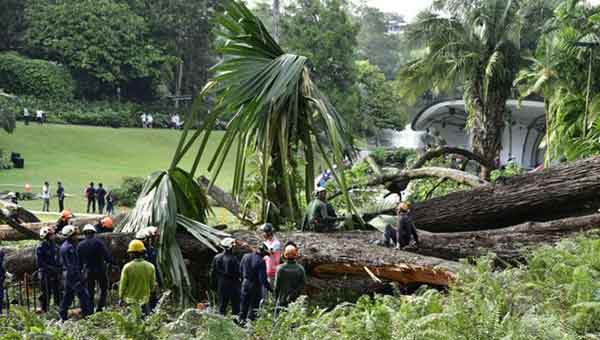
Cluny Rd, Singapore (BBN) - The death of a woman in Singapore after a 270-year-old tree fell on her in the Botanic Gardens has left many shocked and saddened.
With the authorities still investigating, many in the "garden city" are asking how this could have happened, reports BBC.
'IT SOUNDED LIKE THUNDER'
Eyewitnesses in the Botanic Gardens on 11 February told The Straits Times newspaper that they first heard a "cracking sound".
"It sounded like thunder," said 29-year-old Jonathan Ang.
Seconds later, the 40m (131ft) tree crashed to the ground near the garden's outdoor stage, pinning Radhika Angara, a 38-year-old Indian national and Mastercard executive, underneath.
Filipino Lisa Salcedo Arcamo shared on Facebook that she saw "ambulances and medical aid workers rushing down to help those who were trapped".
Angara died, while her husband and their one-year-old twins were injured, along with a 26-year-old Singaporean woman.
"It saddens me to know that such young babies lost their mother after what seemed to be a beautiful family outing," wrote Stefanie Suhashini in a comment on Facebook.
The concert, due to take place on the stage, was cancelled and the area cordoned off.
The huge tree belonged to the Tembusu species and as a listed heritage tree was subjected to inspections twice a year.
It was last checked in September 2016 and was found to be healthy, said Leong Chee Chiew, Commissioner of Parks and Recreation at Singapore's National Parks Board (NParks).
"This includes checks on the root collar, anchoring roots, crown, trunk and signs of soil movement.
The tree was also protected by a lightning conductor and fenced off to prevent compaction of its root zone by visitors," Leong said in a statement to BBC News.
WHAT ARE TEMBUSU TREES?
Native to Singapore, the large evergreens can grow up to 40m tall.
Their trunks have a distinctive dark brown fissured bark, it has light green leaves and bears fragrant white flowers.
They also bear tiny red berries that take at least three months to ripen.
A Tembusu tree features on Singapore's $5 note.
NParks said it has "a systematic regime of inspection checks" and deploys more than 500 certified arborists.
"To adapt to the increasingly unpredictable and severe weather conditions, we have also stepped up our inspections and have been taking measures to improve the general health of our trees," Leong said.
He said the department's priority now was to help Angara, her family and the other injured woman.
He would not speculate on the cause while investigations are under way.
'THIS LOOKS BAD FOR SINGAPORE'
Singapore, the "garden city", is famously safe, but accidents involving trees, especially the many planted along roads and highways, are not uncommon.
In another incident on Saturday, a woman was seriously injured when a tree fell in a car park, crushing the window of a parked lorry.
The accidents have unsettled Singaporeans and on social media, many have been demanding answers.
"What's happening? This looks really bad for Singapore.
We have trains that are breaking (down), roads that are flooding and now our trees that are falling," said Jonus Jun on Facebook.
Others raised concerns about the safety of such huge trees.
"Are the trees here even safe anymore?
Is there a way to check if tree roots are weakening?" said Robert Ridzuandowski.
"We can't get rid of all the trees in Singapore but surely there must be a way to improve the checks to prevent such tragic mishaps from happening again."
"Shouldn't trees have their roots planted deeper into the ground for better stability?
Looks like this tree was only a few feet into the ground," said another user.
'NATURE IS UNPREDICTABLE'
Experts have said the Botanic Garden incident was not "straight-forward".
"Tembusu trees are good and hardy and grow in the toughest of conditions but just because this one was very old doesn't mean it was not dangerous," Goh Mia Chen vice-president of the Singapore Arboriculture Society, told the BBC.
"Structural failure is something to note. There could have been external factors involved like strong wind, termites and fungal infections too."
"Here was a robust tree that was well-managed and regularly checked," said Shawn Kaihekulani Yamauchi Lum, a tropical rainforest ecologist and senior lecturer at the Nanyang Technological University's Asian School of the Environment.
He has worked with NParks closely in the past.
"Trees like this one are very well-adapted to dealing with their surroundings, like extraordinarily strong bursts of winds and wet weather," he said.
"This was not a species known to be weak or associated with tree fall."
While Lum has not visited the site to look at the fallen tree yet, he said he'd been told the root system looked to have been in good condition.
"This is what makes it so perplexing and challenging to work out.
You can do everything possible to minimise the risks of accidents but nature is unpredictable," he said.
"Due diligence had been done. Officials in Singapore know their trees and have a profound sense of responsibility to understand that this is nature and therefore has a certain unpredictability about it."
BBN/MS/SK